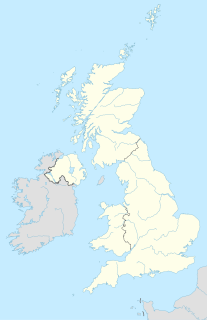
According to the 2011 census, the total population of the United Kingdom was around 63,182,000. It is the 21st-most populated country in the world. Its overall population density is 259 people per square kilometre, with England having a significantly higher population density than Wales, Scotland and Northern Ireland. Almost one-third of the population lives in England's southeast, which is predominantly urban and suburban, with about 9 million in the capital city of London, the population density of which is just over 5,200 per square kilometre.

Demographics of Wales include the numbers in population, place of birth, age, ethnicity, religion, and number of marriages in Wales.
Anglo-Celtic Australians are Australians whose ancestors originate wholly or partially in the countries of England, Wales, Scotland and Ireland.
The United Kingdom Census 1901 was the 11th nationwide census conducted in the United Kingdom of Great Britain and Ireland, and was done on 1 April 1901 "relating to the persons returned as living at midnight on Sunday, March 31st".

Coincident full censuses have taken place in the different jurisdictions of the United Kingdom every ten years since 1801, with the exceptions of 1941 and Ireland in 1921. Simultaneous censuses were taken in the Channel Islands and the Isle of Man, with the returns being archived with those of England. In addition to providing detailed information about national demographics, the results of the census play an important part in the calculation of resource allocation to regional and local service providers by the governments of both the UK and the European Union. The most recent UK census took place in 2011.
The foreign-born population of the United Kingdom includes immigrants from a wide range of countries who are resident in the United Kingdom. In the period January to December 2016, there were groups from 22 foreign countries that were estimated to consist of at least 100,000 individuals residing in the UK.
The United Kingdom Census of 1841 recorded the occupants of every United Kingdom household on the night of 6 June 1841. The enactment of the Population Act 1840 meant a new procedure was adopted for taking the 1841 census. It was described as the "first modern census" as it was the first to record information about every member of the household, and administered as a single event, under central control, rather than being devolved to a local level. It formed the model for all subsequent UK censuses, although each went on to refine and expand the questions asked of householders.
Spaniards in the United Kingdom are people of Spanish descent resident in Britain. They may be British citizens or non-citizen immigrants.
Ukrainians in the United Kingdom consist mainly of British citizens of Ukrainian descent.
The term Other White is a classification of ethnicity in the United Kingdom and has been used in documents such as the 2011 UK Census to describe people who self-identify as white persons who are not of the English, Welsh, Scottish or Irish ethnic groupings. The category does not comprise a single ethnic group but is instead a method of identification for white people who are not represented by other white census categories. This means that the Other White group contains a diverse collection of people with different countries of birth, languages and religions. Along with White British and White Irish, the category does not appear in Northern Ireland, where only one single "White" classification was presented to respondents.
Malaysians in the United Kingdom are British citizens who have full or partial Malaysian origin or descent and Malaysian citizens residing in the United Kingdom. The 2001 UK Census recorded 49,886 Malaysian-born people. The 2011 census recorded 62,396 people born in Malaysia living in England, 2,117 in Wales, 4,721 in Scotland and 705 in Northern Ireland. The largest concentrations of Malaysian-born residents were recorded in Greater London and South East England (11,331). The Office for National Statistics estimates that 75,000 Malaysian-born immigrants were resident in the UK in 2017.

The following outline is provided as an overview of and topical guide to the United Kingdom of Great Britain and Northern Ireland; a sovereign state in Europe, commonly known as the United Kingdom (UK), or Britain. Lying off the north-western coast of the European mainland, it includes the island of Great Britain—a term also applied loosely to refer to the whole country—the north-eastern part of the island of Ireland and many smaller islands

British Tamils are British people of Tamil origin. The term is used to denote people who have their homeland in Indian state of Tamil Nadu, or in northern areas of Sri Lanka.
New Zealanders in the United Kingdom are citizens or residents of the United Kingdom who originate from New Zealand.

The United Kingdom (UK) comprises four countries: England, Scotland and Wales and Northern Ireland.
Nepalese in the United Kingdom are British citizens or full-time residents of the United Kingdom whose ethnic origins lie fully or partially in Nepal.

A census of the population of the United Kingdom is taken every ten years. The 2011 census was held in all countries of the UK on 27 March 2011. It was the first UK census which could be completed online via the Internet. The Office for National Statistics (ONS) is responsible for the census in England and Wales, the General Register Office for Scotland (GROS) is responsible for the census in Scotland, and the Northern Ireland Statistics and Research Agency (NISRA) is responsible for the census in Northern Ireland.
Swedes in the United Kingdom are immigrants from Sweden living in the United Kingdom as well as their British-born descendants. Although only around 38,000 Swedish-born people live in the UK, millions of Britons have some degree of Scandinavian ancestry that dates back over 1,000 years to the Viking invasion of Great Britain. The Swedish community in the UK is amongst the largest in the Swedish diaspora; in 2001 only the United States, Norway and Finland within the OECD had larger Swedish-born populations.











